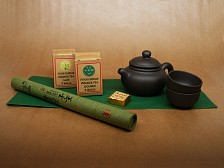
|
Bamboo drinking straw
|
Bamboo drinking straw, ideal for Guayusa, Matè and other drinks. Approximate dimensions: Diameter 7-8 mm, inner diameter 3-4 mm, length 19-20 cm. |

|
Blue Lotus flower petals
|
These beautifully dried Blue Lotus petals and golden stamens—harvested from Nymphaea caerulea, the Egyptian Blue Water Lily |
3 Forms |

|
Blue Lotus whole flowers
|
These dried whole blossoms of Nymphaea caerulea, commonly known as Blue Lotus or Egyptian Blue Water Lily are sourced from small, traditional family farms in Thailand. |
2 Forms |

|
Canela leaves
|
In the Brazilian Amazon this particular extensive family of trees is referred to as Canela or Caneleiro. Canela is the Portuguese word for Cinnamon. The leaves are thus called “Folha de Canela” or in English Cinnamon leaf. They make a light flavoured very nice aromatic tea that reminds of Cinnamon. |

|
Cat's Claw
|
Cat’s Claw (Uncaria tomentosa), known in the Amazon as Uña de Gato, is a climbing forest vine named for its curved claw-like thorns. |
2 Forms |

|
Chaga mushroom
|
Chaga mushroom is parasitic on Birch and other trees. The sterile conk is irregularly formed and has the appearance of burnt charcoal. It is not the fruiting body of the fungus, but a mass of mycelium, mostly black due to the presence of massive amounts of melanin. |
3 Forms |

|
Chilcuague root
|
A rare plant used in traditional Mexican cuisine and remedies. The root and the tincture of the root gives a very strong tingling electric sensation in the mouth. The plant produces saliva in the mouth, facilitating the production of beneficial bacteria.This root is used to produce our hugely popular Chilcuague spray and can be used to make your own infusion. |
2 Forms |

|
Clitoria flowers
|
Clitoria flower tea or blue tea, or butterfly pea flower tea, is a caffeine-free herbal concoction, made by seeping dried or fresh leaves of the Clitoria ternatea plant. The best thing about the blue tea is that it is absolutely caffeine-free, and it is packed with antioxidants. The most striking feature about this plant is the colour of its flowers, a vivid deep blue. |
2 Forms |

|
Embauba
|
The Snakewood tree is an evergreen tree usually growing to around 15 metres tall. The tree is harvested from the wild for its edible fruit and leaves. Sometimes it is also grown as an ornamental, being valued for its large, umbrella-shaped canopy that casts only a light shade and so allows other plants to grow underneath it. |

|
Emburana bark
|
Amburana bark, also known as Imburana or Emburana, is revered across Brazil for its fragrance, warmth, and ceremonial presence. |
6 Forms |

|
Emburana seeds
|
Amburana seeds, also known as Imburana or Emburana are ground to add fragrance and balance to Rapé. |
2 Forms |

|
Gift set - Chinese Tea
|
Indulge in the Chinese tea ceremony of Gong Fu, with our beautiful Chinese tea gift set. The style of Gong Fu is centred around the idea of brewing and serving tea as an art and connecting with the mind and body. It is a symbolic ritual that involves brewing and serving tea, and is a way to show respect, celebrate life, and find peace. |

|
Mulungu bark
|
Erythrina has long been used by the indigenous peoples in the Amazon. Tinctures and decoctions made from the leaves or barks of Mulungu. |
5 Forms |

|
Muna
|
Muna is a very tasty mint-like tea and an excellent aphrodisiac. |

|
Sarsaparilla
|
Sarsaparilla an ancient herb from Mexico. |
2 Forms |